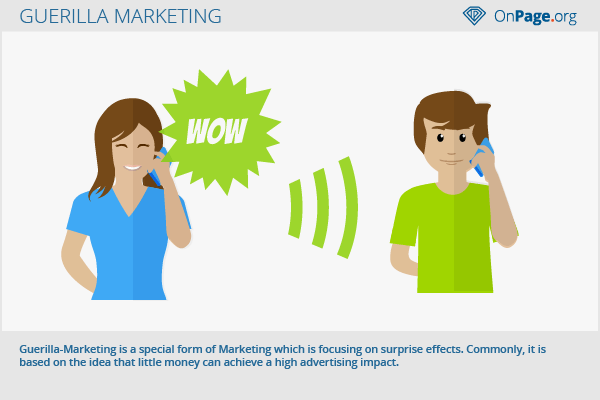Guerilla Marketing
Guerilla-Marketing is a special form of Marketing focuses on surprise effects. Commonly, it is based on the idea that little money can achieve a high advertising impact. The idea of Guerilla marketing was established by the marketing professional Jay C. Levinson, who developed the concept in the 1980s. Guerilla tactics are particularly useful with online marketing campaigns above all, as here, a high virality can be targeted for example through Social Media.gr
Definition
Guerilla-Marketing is a concept which is based on unconventional methods to surprise the consumers. The achieved attention makes it so efficient and the financial benefit is relatively low compared to classic, expensive advertising campaigns. Unconventional and untypical measures are used for Guerilla campaigns which should be unprecedented. So in general a Guerilla-Marketing campaign cannot be started a second time without changing the actions. The basic principle is to provoke discussions so it goes viral on Social Media, PR and by word of mouth. When replying the same campaign there would be no surprise effect and automatically no interest of the public. In the worst case the second time could have a negative impact. This could be the case when the target group gets bored and so the positive effect of the first run could be turned around to the opposite.
Purpose of Guerilla-Marketing
The purpose of Guerilla Marketing is to increase the reach by advertising. The classic advertisement has to fight a shrinking reach for years. This could be lead back to the tremendous overstimulation that consumers are confronted with. Every day 2,500 to 10,000 different advertisements are moved in the consumers’ awareness. The main aim of a Guerilla campaign is to stand out from the masses and to make “its voice heard”.
Principle of Guerilla-Marketing
Guerilla-Marketing campaign are based on certain effect mechanisms which lead to a sort of Aha-effect. This makes the cosumers tell other people of the campaign and take it out into the world. So the consumers get shocked, laugh gloatingly, break taboos and laugh at the company’s competitors.
The "founder" of this advertising technique, Jay C. Levinson, quoted the following aspects as typical for Guerilla marketing:
- Guerilla marketing touches on common sense. It is therefore independent of experience, assumptions or evaluations.
- Primarily, profit is in the forefront, as opposed to percentage of sales.
- New customer relationships can be built monthly
- The campaigns are designed in particular for individual products and not for general areas.
- The focus of the campaigns is the existing customer relationships and recommendations. Building up new customers is secondary.
- A co-operation with other firms is preferred rather than observing the competition.
- The customers should be addressed individually. The smaller the target group, the bigger the effect of guerilla marketing.
- A goal of the campaign is the agreement of the customer to provide further information, rather than targeting a conversion.
Examples
By now there are many examples for Guerilla-Marketing. The following campaigns were successful:
- Chocolatier Lindt put rabbit-ears on their company cars and hint at their golden Lindt easter bunny.
- Nivea placed a sofa in public with half of its surface smooth and the other one bumpy and uneven. This should show the feeling of cellulitefree skin after using skin care products.
- A gym placed scales in benches of a bus shelter to show the people how urgent the next training would be.
- As an advertisement for “Spider Man 2” a pissoir in the men’s room was placed in a few meters higher than usual - so this was perfect for men who love to climb.
This YouTube-Video shows a few successful examples.
Risks of Guerilla-Marketing
At the first glance Guerilla-Marketing offers a really good chance to achieve a high advertising effect for little money. But there are obvious risks. The viral effect of a Guerilla campaign cannot be controlled, so if it gets viral, it could develop further into all directions, so also in a negative one.
If the target group reacts in an upset or uncomprehending way, the campaign could provoke a shitstorm which in return could lead to a loss of image and sales. So when planning a Guerilla-Marketing campaign, all possible scenarios have to be taken into consideration so in worst-case scenario everybody knows how to react. A solid tracking and monitoring system of the user behavior is important. By means of this data, conclusions can be made regarding the reasons for success or failure.

